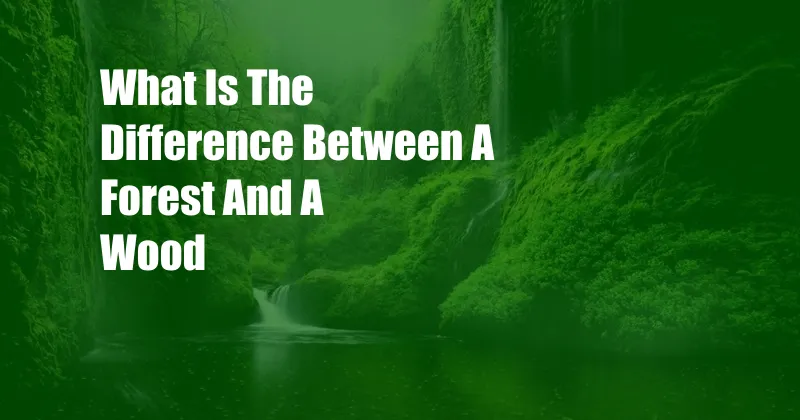
What’s the Difference Between a Forest and a Wood?
As I was strolling through the dense undergrowth of the sprawling Amazon rainforest, the towering trees seemed to whisper secrets to each other, their branches intertwining like a labyrinth. In this wild and untamed expanse, I couldn’t help but wonder, is this a forest or a wood?
Forest vs. Wood: A Tale of Scale and Density
The distinction between a forest and a wood lies primarily in their size and density.
-
Forest: A vast, natural ecosystem dominated by trees, covering an extensive area. Forests exhibit complex ecological processes, supporting a wide array of plant and animal life.
-
Wood: A smaller area of trees, usually managed for a specific purpose such as timber production or recreation. Woods are often planted or maintained by humans, and the tree species composition may be more uniform.
Characteristics of a Forest
Forests are characterized by:
- Size: Typically covering thousands of acres or more
- Density: Trees are densely packed, creating a closed canopy
- Variety: Rich biodiversity of tree species, along with diverse understory vegetation and wildlife
- Age: Old-growth forests have trees that are hundreds or even thousands of years old
- Ecosystem Services: Forests provide vital ecosystem services such as carbon sequestration, water filtration, and habitat for countless species
Characteristics of a Wood
Woods, on the other hand, are distinguished by their:
- Size: Smaller than forests, often covering only a few acres to a few hundred acres
- Density: Trees may be more spaced out, allowing for more light penetration
- Purpose: Often managed for specific human purposes such as timber production or recreation
- Tree Composition: May have a more limited range of tree species, favoring those suitable for the desired outcome
- Human Intervention: Woods are often planted or maintained by humans, with regular harvesting or selective thinning
Trends and Developments in Forest and Wood Management
Forest Conservation: Recognizing the critical role of forests in maintaining biodiversity and ecosystem services, global efforts are underway to protect and restore them.
Sustainable Forestry: The practice of managing forests responsibly, balancing timber production with conservation goals, is becoming increasingly prevalent.
Agroforestry: Integrating trees into agricultural systems to enhance soil health, reduce erosion, and provide additional income for farmers.
Urban Forestry: The planting and management of trees in urban environments to improve air quality, reduce heat island effects, and enhance aesthetics.
Wood Production: Technological advancements in wood harvesting and processing are driving the development of more sustainable and efficient practices.
Expert Tips for Forest and Wood Management
For Forest Conservation:
- Support organizations involved in forest protection and restoration
- Educate others about the importance of forests
- Choose sustainably sourced wood products
For Wood Management:
- Practice sustainable forestry principles
- Use native tree species when planting
- Monitor forest health and adjust management practices accordingly
- Engage with local communities in forest planning and management
FAQ on Forests and Woods
-
Q: What is the legal definition of a forest?
-
A: Definitions vary by country and jurisdiction, but generally, forests are defined as areas with a certain percentage of tree cover and minimum size.
-
Q: What is the difference between a woodland and a forest?
-
A: A woodland is typically smaller than a forest and may have a more open canopy, allowing for more sunlight to reach the ground.
-
Q: Why are forests important?
-
A: Forests provide vital ecosystem services such as air and water purification, carbon sequestration, and habitat for wildlife.
-
Q: How can I help protect forests?
-
A: Support organizations involved in forest conservation, choose sustainably sourced wood products, and educate others about the importance of forests.
Conclusion
Understanding the distinction between a forest and a wood is crucial for effective management and conservation. Forests, vast and complex ecosystems, play a vital role in maintaining global health. Woods, while smaller and often managed for specific purposes, also provide valuable resources and contribute to the ecological balance. By recognizing the differences and adopting sustainable practices, we can ensure the preservation of these precious natural assets for future generations.
Are you interested in learning more about the fascinating world of forests and woods? Explore additional resources and join the conversation online.